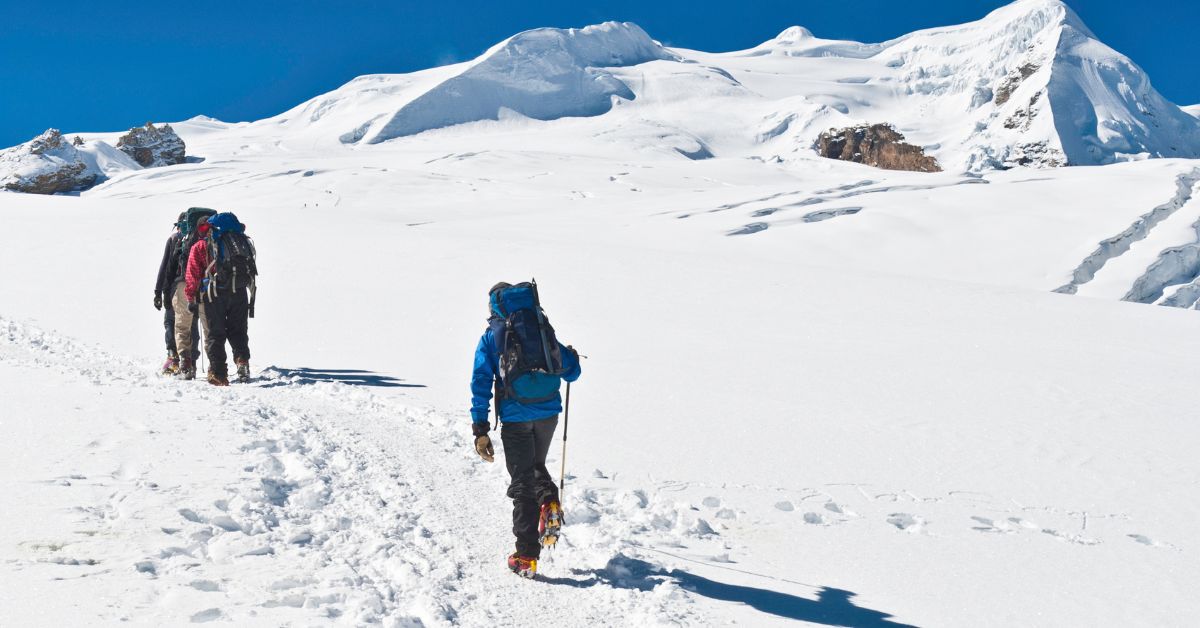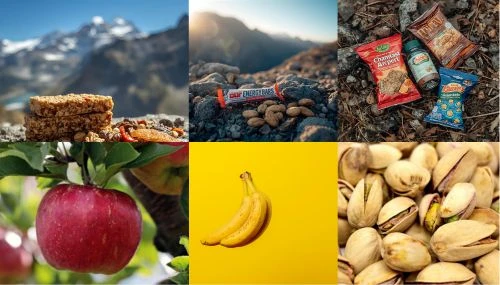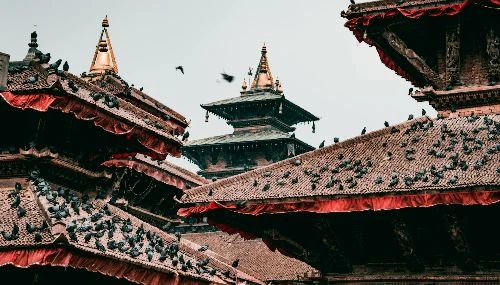The stunning Mera Peak is one of the highest trekking peaks standing tall at 6,476 meters.
It consists of three main summits, namely Mera North (6,476 meters), Mera Central (6,461 meters), and Mera South (6,065 meters). Other minor trekking peaks are also visible as a distinct summit from the south.
British mountaineers Jim Roberts and Sen Tenzing first climbed the mountain on the 20th of May 1953. Before that, British expeditions explored the region in the early 50s. Edmund Hillary, Tenzing Norgay, Eric Shipton, and George Lowe were members of those teams.
Since then, the mountain has been a popular destination for climbers and adventurers seeking to challenge themselves and experience the stunning beauty of the Himalayas.
It is believed that French climbers Marcel Jolly, G. Baus, and L. Honills first climbed the Mera North in 1975. Likewise, Mal Duff and Ian Tattersall first ascended the southwest pillar in 1986.
Hari Budha Magar successfully summited Mera Peak in September 2017. His achievement made him recognized as the first ever double above-knee amputee to climb a peak over 6,000m.
Location of Mera Peak
Mera Peak lies in the Solu Khumbu region of the Himalayas in Nepal. It is a part of the Mahalangur section, Barun sub-section of the Himalayas.
How to get to Mera Peak?
The trekkers can start their journey to the peak from Kathmandu. You can take a flight to Lukla from Kathmandu.
From Lukla, you will pass through traditional Sherpa villages and remote valleys. You will also go along the Dudh Koshi River on the way.
It takes around 7 to 10 days to trek to Mera Peak Base Camp. While on the way, you will pass through several small villages, camping sites, and stay-in tea houses.
Required permits and fees
To ascend Mera Peak, you will need two permits; a climbing permit and a Makalu Barun National Park Permit.
Mera Peak climbing permit is available at the Nepal Mountaineering Association (NMA). The Nepal Tourism Board office at Bhirkutimandap, Kathmandu, distributes trekking grants. It costs around USD 70 to 250, depending on the season.
Regarding the National Park Permit, it costs USD 15 for SAARC nationals, while it costs USD 30 for other nations.
Best time of year to climb Mera Peak
The best time to climb the peak is from March to May and September to November.
This is because the weather is favorable during spring and fall. The skies are also clear. Furthermore, the views of the surrounding peaks are very impressive during those seasons.
The region gets extremely cold during winter, from December to February. The temperatures drop below freezing point at night. So, climbing Mera Peak during winter is usually not recommended as there is an increased risk of avalanches and other hazards.
Similarly, the mountain is unfavorable for climbing during monsoon, from June to August. The region experiences heavy rainfall, and the trail becomes muddy and slippery.
Highlights of the climb
Scenery and views from Mera Peak
Mera Peak offers spectacular views of Mount Everest, Lhotse, Makalu, Cho Oyu, and Kanchenjunga.
You can also witness a 360-degree panoramic Himalayan landscape at the top of Mera Peak. The trekking trail takes you through remote valleys and dense forests.
Cultural experiences along the way
During the journey, you will explore the ancient monasteries, learn about the local culture, and witness traditional Sherpa ceremonies.
The Sherpa people have long lived in the region. They have developed a deep connection with the mountains. Sherpas also serve as local guides, porters, and support staff for climbers and trekkers worldwide.
Thus, you will get to observe the lifestyle and customs of the local people, along with their unique clothing, food, and architecture. The traditional stone houses decorated with prayer flags, mani walls (stone structures inscribed with Buddhist prayers), and chortens (stupas) attract visitors' attention.
There are also ancient Buddhist monasteries filled with ornate artwork, religious relics, and centuries-old scriptures. Trekkers and travelers can attend religious ceremonies and meet with monks.
Challenges and rewards of climbing Mera Peak
Climbing Mera Peak is a highly sought-after destination as it is challenging yet rewarding.
The trekkers will have to hike for over a week.
The weather, trails, and altitude will test your patience and dedication. But the view of the snow-capped peaks stretching out in all directions from the summit of the peak will melt your heart and soul.
It also provides a sense of accomplishment and growth to the climbers. Furthermore, you will cherish the experience and memories you created during the trip for a lifetime.
Climbing Mera Peak

Difficulty level and experience required
Mera Peak is a high-altitude peak. So, it requires proper acclimatization and basic mountaineering skills. Furthermore, it is a moderately difficult climb.
The climb involves glacier travel, steep snow, and ice slopes. You will have to use mountaineering equipment such as crampons and ice axes.
Your previous climbing experience will help you in many ways. You will be familiar with the challenges waiting for you. It will also help you tackle unpredictable situations.
If you have previously ascended other peaks, you will be comfortable using essential mountaineering equipment and techniques. You will also have the skills of roped travel and crevasse rescue.
Recommended gear and equipment
Here are the gears and equipment that you must carry while embarking on your journey to Mera Peak:
Clothing:
- Quick drying tops and bottoms
- Down jackets and plants
- Fleece jackets, sweaters, and trousers
- Waterproof and windproof outer layers
- Waterproof and insulated gloves and shocks
- Warm hats
- A good pair of mountaineering boots
Climbing Equipment:
- Crampons will help improve mobility on snow and ice during ice climbing
- Ice axe for stability on steep slopes
- Climbing harness to secure yourself to ropes during glacier travel and crevasse crossings
- Helmet to protect yourself from potential head injuries in case of rocks falling
- Trekking poles to reduce strain on the knees during long hikes
- Gaiters will protect your lower legs and feet from snow and debris
Camping Gear:
- Sleeping bags to stay warm during sub-zero temperatures
- Sleeping pad for a comfortable sleep
- A lightweight and durable tent that can withstand harsh mountain conditions
- Cooking equipment to prepare meals at high altitudes
Miscellaneous:
- A backpack enough to carry all your gear and equipment
- Headlamps will come in handy during early morning starts and the dark
- UV protective sunglasses to protect your eyes
- Sunscreen with high SPF to protect against intense sunlight at high altitudes
- First aid kit and your basic medical supplies
Training and preparation for climbing Mera Peak
Ascending Mera Peak is physically demanding. So, it requires a certain level of physical fitness.
- Physical Fitness
Starting hiking, running, cycling, or swimming a few weeks or months before the journey will improve your cardiovascular fitness. Likewise, squats, lunges, and stair climbing will strengthen your leg muscles.
Focusing on planks, push-ups, and pull-ups will strengthen your core and upper body. It will improve stability and balance during the climb.
- Mental Preparation
To summit the peak, mental preparation is as crucial as physical preparation.
You should cultivate a positive mindset and remain determined until you achieve your goal.
- Gear Familiarization
You should get familiar with all your gear and equipment. It will make you aware of the proper usage and maintenance.
Furthermore, testing your gear before ascending is necessary to ensure everything functions properly and fits well.
Safety considerations
While climbing the peak, safety is the priority. Make sure you prevent getting injured during the trip.
Risks and hazards of climbing
Altitude sickness: Since Mera Peak is at a high altitude, it increases the risk of altitude-related illnesses. The travelers might suffer from acute mountain sickness (AMS), high-altitude pulmonary edema (HAPE), and high-altitude cerebral edema (HACE).
To prevent those illnesses, you must ascend slowly while maintaining your pace. You must be very cautious and aware of the symptoms before it worsens. If you suffer from altitude sickness, descending to lower elevations is necessary.
Extreme weather conditions: The weather in the Himalayas is unpredictable and harsh. There can be sudden changes in temperature, strong winds, and snowstorms.
Closely monitoring the weather forecast before making your move is necessary. It will prepare you for adverse conditions.
Avalanches and rockfalls: There are high chances of avalanches and rockfalls on steep slopes and during snowmelt. So, avoiding areas prone to such hazards will keep you safe.
Fatigue and physical exhaustion: Ascending the Mera Peak takes 15 to 17 days. Thus, it requires a high level of fitness and commitment.
You can suffer fatigue and exhaustion while trekking through steep ascents for hours. Taking enough rest and managing your energy levels are crucial to prevent injuries or accidents.
Mera Peak Safety precautions and emergency procedures
Travelers should always be prepared for potential emergencies while climbing any peaks. We have mentioned some safety precautions and emergency procedures to consider:
Acclimatization: Proper acclimatization will minimize the risk of altitude-related illnesses. Maintaining your pace and taking enough rest at higher elevations is important. Likewise, you should also monitor your health often.
Communication: Communicating with your team throughout the climb is the key to ensuring trust, safety, and support for each other. So, carry reliable communication devices like satellite phones or radios to stay connected in emergencies.
Weather Monitoring: The weather at Mera Peak is unpredictable, so learning about the weather conditions before and during the climb will be helpful. It will update you on weather forecasts and prepare you for challenging weather patterns. Sometimes you must adjust your itinerary according to the weather demands.
Emergency Evacuation Plan: Remain familiar with the emergency evacuation procedures in the area. Having travel insurance covering emergency helicopter evacuations would be better. Also, share your travel plans and emergency contacts with your reliable friends and family.
First Aid and Medical Supplies: You should always carry a well-stocked first aid kit with all your essential medical supplies. Pain relievers, bandages, disinfectants, and other medications will be convenient.
Emergency Shelter: Always have lightweight emergency shelters. Bivvy bags or emergency tents will provide shelter in unexpected circumstances, such as getting caught in a storm or waiting for rescue.
Climbing Mera Peak combines adventure, culture, and stunning natural beauty. This unique experience ensures personal growth, self-discovery, and a sense of accomplishment.
So, if you are an adventurous and nature-loving person looking forward to going on a trip as a city escape, add it to your bucket list. You will forever cherish the unforgettable memories that you made along the journey.


.webp)

